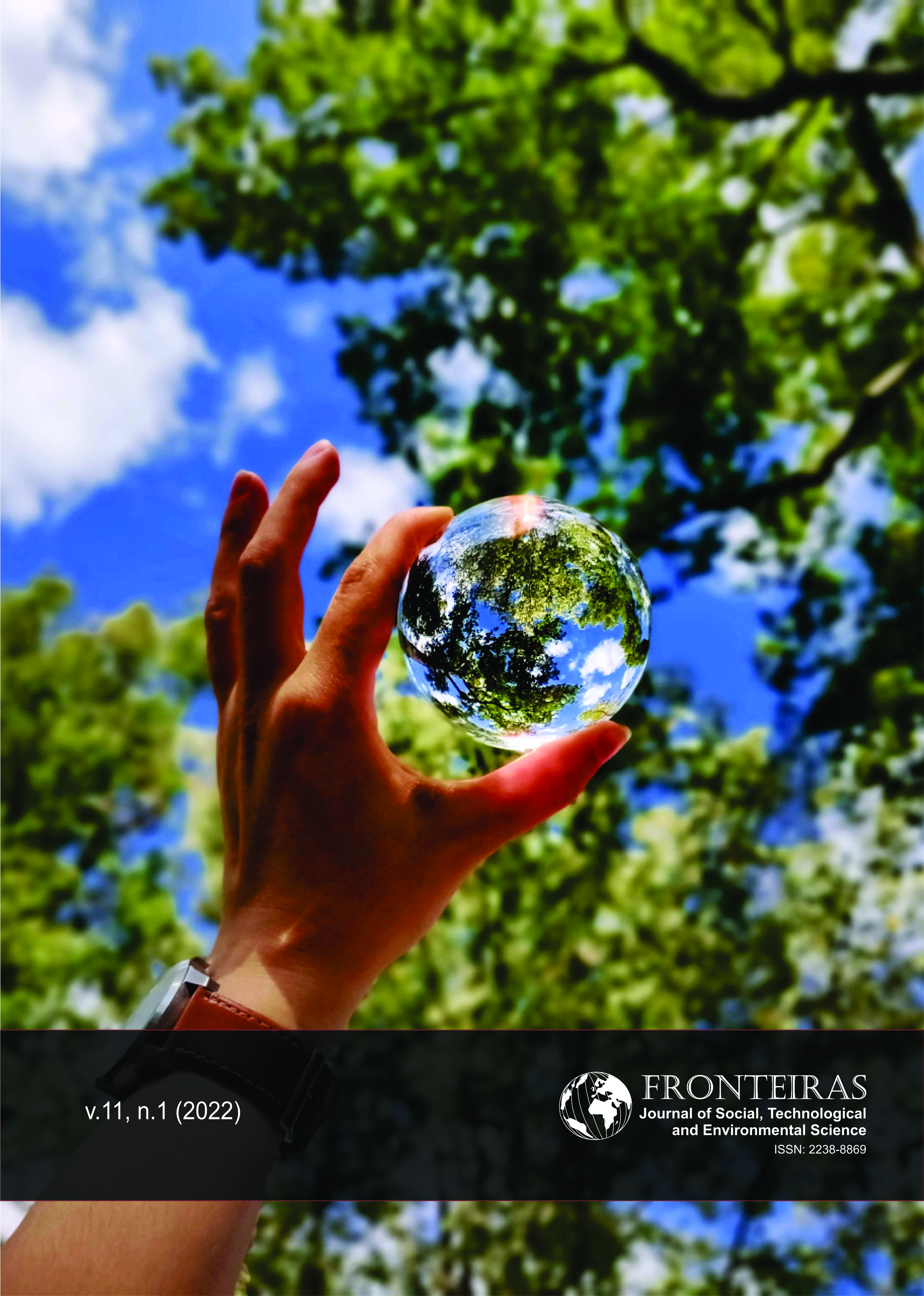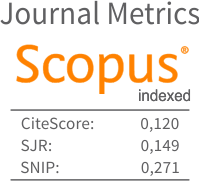Análise dos Parâmetros Limnológicos de um Rio Inserido em uma Paisagem Antropizada
DOI:
https://doi.org/10.21664/2238-8869.2022v11i1.p288-301Palavras-chave:
limnologia aplicada, Guidelines, ecossistema aquático, águas interioresResumo
A qualidade da água depende da interação entre os processos naturais e as atividades antrópicas que ocorrem na bacia hidrográfica. O Cerrado é o segundo maior bioma do Brasil; sendo responsável por abranger ca. 43% da água superficial fora da Amazônia; todavia, esse bioma tem sido convertido em outros usos da terra, alterando a qualidade da água e afetado negativamente os usos desse recurso pela sociedade. Neste sentido, o monitoramento ambiental e a adoção de parâmetros ambientais de referência permitem a classificação de corpos hídricos e a promoção dos usos múltiplos da água. Sendo assim, partindo do questionamento sobre a interferência antrópica nas variáveis limnológicas na bacia hidrográfica do rio Jacaré-Guaçu, buscou-se testar hipóteses sobre a modificações entre as variáveis em relação aos cursos do rio, às estações hidrológicas (seca e cheia) e entre 2015 e 2016. Para tal, foram utilizados os dados de 15 variáveis limnológicas disponibilizadas pela Companhia Ambiental do Estado de São Paulo (CETESB). O emprego do Diagrama de Pareto e de análises estatísticas mostraram a existência de não conformidades de algumas variáveis limnológicas, alterações no gradiente longitudinal do rio Jacaré-Guaçu com forte influência da sazonalidade.
Referências
APHA (American Public Health Association) 1998. Standard methods for the examination of water and wastewater. Washington D.C.
Arruda ROM, Dalmas FB, Militão FA, Santos JC, Garcia AP 2016. Análise geoambiental aplicada ao estudo da relação entre qualidade da água e ocupação das margens da represa Guarapiranga (São Paulo/SP), entre 2004 e 2014. Rev UNG Geociências 15(1): 77 – 93.
Azevedo SMC, Vasconcelos DV, Avelar JCL 2014. Análises físico-químicas do corpo hídrico na fazenda São Gonçalo em Paraty (RJ). Rev Iberoam Cien Amb 5(1): 329–334.
Barcellos CM et al 2006. Avaliação da qualidade da água e percepção higiênico-sanitária na área rural de Lavras, Minas Gerais, Brasil, 1999-2000. Cad Saúde Pub 22(9): 1967 - 1978.
Brasil. Lei n. 9.433, de 8 de janeiro de 1997. Institui a Política Nacional de Recursos Hídricos. Available from: http://www.planalto.gov.br/ccivil_03/Leis/l9433.htm.
Brasil. Lei n° 12.651, de 25 de maio de 2012. Dispõe sobre a proteção da vegetação nativa; altera as Leis nos 6.938, de 31 de agosto de 1981, 9.393, de 19 de dezembro de 1996, e 11.428, de 22 de dezembro de 2006; revoga as Leis nos 4.771, de 15 de setembro de 1965, e 7.754, de 14 de abril de 1989, e a Medida Provisória no 2.166-67, de 24 de agosto de 2001; e dá outras providências. Available from:http://www.planalto.gov.br/ ccivil_03/_ato2011-2014/2012/lei/l12651.htm.
Brasil. Resolução CONAMA n° 357, de 17 de março de 2005. Dispõe sobre a classificação dos corpos de água e diretrizes ambientais para o seu enquadramento, bem como estabelece as condições e padrões de lançamento de efluentes, e dá outras providências. Available from: http://www.mma.gov.br/port/conama/legiabre.cfm?codlegi=459.
Buzelli GM, Cunha-Santino, MB 2013. Análise e diagnóstico da qualidade da água e estado trófico do reservatório de Barra Bonita (SP). Rev Ambi-Água 8(1): 186 - 205.
Calvão, LB, Juen, L, Oliveira Júnior, JMB, Batista, JD, Marco Júnior, P 2018. Land use modifies Odonata diversity in streams of the Brazilian Cerrado. J. Insect Conserv. 22:675-685.
Centro de Pesquisas Meteorológicas e Climáticas Aplicadas a Agricultura – Cepagri 2018. Clima dos municípios paulistas. Available from: https://www.cpa.unicamp.br/outras-informacoes/clima-dos-municipios-paulistas.html
Companhia Ambiental do Estado de São Paulo – CETESB 2017a. Qualidade das águas interiores no estado de São Paulo 2016. Available from:http://aguasinteriores.cetesb.sp.gov.br/wp-content/uploads/sites/12/2013/11/Cetesb_QualidadeAguasInteriores_2016_corre%C3%A7%C3%A3o02-11.pdf
Companhia Ambiental do Estado de São Paulo – CETESB 2017b. Apêndice E: Significado ambiental e sanitário das variáveis de qualidade das águas e dos sedimentos e metodologias analíticas de amostragem. Available from:http://aguasinteriores.cetesb.sp.gov.br/wp-content/uploads/sites/12/2018/03/Ap%C3%AAndice-E-Significado-Ambiental-e-Sanit%C3%A1rio-das-Vari%C3%A1veis-de-Qualidade-2016.pdf
Companhia Ambiental do Estado de São Paulo – CETESB 2018. [database on the Internet]. Águas interiores - Publicações e Relatórios [cited 2018 Maio12]. Available from: http://cetesb.sp.gov.br/aguas-interiores/publicacoes-e-relatorios.
Costa, RT, Gonçalves, CF, Fushita, AT, Santos, JE 2017. Land Use/Cover and naturalness changes for watershed environmental management (Southastern Brazil). Journal of Geoscience and Environment Protection 5(11):1-14.
Cunha, ER, Santos, CAG, Silva, RM, Bacani, VM, Pott, A 2020. Future scenarios based on a CA-Markov land use and land cover simulation model for a tropical humid basin in the Cerrado/Atlantic forest ecotone of Brazil. Land Use Policy [serial on the Internet]. 2020 out [cited 2020 Nov 25]:[about 17 p.]. Available from: https://www.sciencedirect.com/science/article/abs/pii/S0264837720303288
Damasceno et al. 2015. Seasonal evaluation of the quality of surface waters of the Amazon River on the waterfront of Macapá City, Amapá, Brazil. Rev Amb & Água 10(3):598-613.
Furtado CM, Lopes MRM 2015. Influência do pulso de inundação sobre variáveis limnológicas de um trecho urbano do rio Acre, Rio Branco, Acre, Brasil.Rev Amb 11(1):133–148.
Härdle, WH, Simar, L 2015. Applied Multivariate Statistical Analysis. Springer-Verlag, Berlin Heidelberg, 580 pp.
Mapbiomas [homepage on the Internet]. Infográficos [cited 2020 Nov. 25]. Available from: https://mapbiomas.org
Newbold JD, Elwood JW, O'neill RV, Winkle WV 1980. Measuring Nutrient Spiraling in Streams.Can J Fish Aquatic Sci 38(7): 860 - 863.
Nóbrega, RLB, Guzha, AC, Lamparter, G, Amorim, RSS, Couto, EG, Hughes, HJ, Junkgkunst, HF, Gerold, G 2018. Impacts of land-use and land-cover change on stream hydrochemistry 1in the Cerrado and Amazon biomes. Sci. Total Environ. 635:259-274.
Noriega CD et al. 2017. Distribuição espacial da biomassa fitoplanctônica e sua relação com os sais nutrientes, no Sistema Estuarino de Barra das Jangadas (Pernambuco – Brasil).Arch Cien Mar 38(1–2):5–18.
Oliveira EZ, Fushita AT, Cunha-Santino MB, Bianchini Jr, I 2017. Water and sediment quality assessment - Ribeirão do Laranjal watershed. Rev Cien Tecn Amb 5(1): 30 - 39.
Periotto, NA, Tundisi, JGA 2018. A characterization of ecosystem services, drivers and values of two watersheds in São Paulo State, Brazil. Braz J Biol 78(3)397–407.
R Core Team 2018. R: A language and environment for statistical computing. R Foundation for Statistical Computing, Vienna, Austria. Available from: https://www.R-project.org/.
Resende, FM, Denman, LAC, Selva, GV, Campanhão, LMB, Nobre, RLG, Jimenez, YG, Lima, EM, Niemeyer, J 2020. A conceptual model to assess the impact of anthropogenic drivers on water-related ecosystem services in the Brazilian Cerrado. Biota Neotrop. 20: e20190899.
Santos JP, Martins I, Callisto M, Macedo DR 2017. Relações entre qualidade da água e uso e cobertura do solo em múltiplas escalas espaciais na bacia ro Rio Pandeiros, Minas Gerais. Rev Espinhaço 6(2):36-46.
São Paulo. Decreto Estadual n° 10.755, de 8 de setembro de 1977. Available from: https://www.al.sp.gov.br/repositorio/legislacao/decreto/1977/decreto-10755-22.11.1977.html.
São Paulo. Decreto Estadual n° 8.468, de 8 de setembro de 1976. Available from: http://www.al.sp.gov.br/repositorio/legislacao/decreto/1976/decreto-8468-08.09.1976.html.
São Paulo [homepage on the Internet]. Infográficos [cited 2020 Nov. 25]. Available from: https://smastr16.blob.core.windows.net/home/2020/07/tabela-ugrhi-inventario-florestal-if-2020.pdf
Silva FL, Silva GC, Fushita AT, Bianchini Jr I, Cunha-Santino MB 2017. Qualidade das águas e hemerobia do córrego do Mineirinho, São Carlos, SP. Rev Bras Geo Fis 11(6):1921 - 1933.
Silva MA, Araújo RR 2017. Análise temporal da qualidade da água no córrego Limoeiro e no rio Pirapozinho no Estado de São Paulo - Brasil. Rev Form 1(24):182-203.
Silva, DAL., Delai, I., Castro, MAS., Ometto, AR 2013. Quality tools applied to cleaner production programs: a first approach toward a new methodology. J. Clean. Prod. 47:174-187.
Silva, FL, Stefani, MS, Smith, WS, Schiavone, DC, Cunha-Santino, MB, Bianchini Jr, I 2020. An applied ecological approach for the assessment of anthropogenic disturbances in urban wetlands and the contributor river. Ecological Complexity 43: 100852.
Strahler AN 1952. Hypsometric (area-altitude) analysis of erosional topography. Geological Society of America Bulletin63. Available from: http://www.unc.edu/courses/2010spring/geog/591/001/students/nmey13/GEOL483/Lab5/pdfs/Strahler_1952_hypsometry.pdf.
Strassburg, BN, Brooks, T, Feltran-Barbieri, R, Iribarrem, A, Crouzeilles, R, Loyola, R, Latawiec, AE, Oliveira-Filho, FJB, Scaramuzza, CAM, Scarano, FR, Soares-Filho, B, Balmford, A 2017. Moment of truth for the Cerrado hotspot. Nat. Ecol. Evol. 1(0099):1-3.
Tanaka MO, Souza ALT, Oliveira AK, Moschini LE 2015. Redundância entre métricas da qualidade ambiental de riachos em paisagem agrícola. Ambi-Água 10(4): 832 – 846.
Trevisan, DP, Bispo, PC, Almeida, D, Imani, M, Balzter, H, Moschini, LE 2020. Environmental vulnerability index: an evaluation of the water and the vegetation quality in a Brazilian Savanna and Seasonal Forest biome. Ecol. Indic 112: 106163.
Tundisi JG, Matsumura-Tundisi T 2010. Impactos potenciais das alterações do Código Florestal nos recursos hídricos. Bio Neot 10(4): 67–75.
Tundisi JG, Matsumura-Tundisi T, Pareschi DC, Luzia AP, Von Haeling PH, Frollini EH 2008. A bacia hidrográfica do Tietê/Jacaré: estudo de caso em pesquisa e gerenciamento. Est Avan 22(63): 159 – 172.
Vannote RV, Minshall GW, Cummins KW, Sedell JR, Cushing CE 1980. The River Continuum Concept. Can J Fish Aquatic Sci 37(1):130 - 137.
Veras, DS, Castro, ER, Lustosa, GS, Azevêdo, CAS, Juen, L 2019. Evaluating the habitat integrity index as a potential surrogate for monitoring the water quality of streams in the cerrado-caatinga ecotone in northern Brazil. Environ. Monit. Assess. 191(562):1-9.
Zeilhofer, P, Alcantara, LH, Fantim-Cruz, I 2018. Effects of Deforestation on Spatio-Temporal Runoff Patterns in the Upper Teles Pires Watershed, Mato Grosso, Brazil. Rev. Bras. Geogr. Fís 11(5):1889-1901.
Zeilhofer, P, Calheiros, DF, Oliveira, MD, Dores, EFGC, Lima, GAR, Fantin-Cruz, I 2016. Temporal patterns of water quality in the Pantanal floodplain and its contributing Cerrado upland rivers: implications for the interpretation of freshwater integrity. Wetl. Ecol. Manag. 24:697-7
Downloads
Publicado
Como Citar
Edição
Seção
Licença
Esta revista oferece acesso livre imediato ao seu conteúdo, seguindo o princípio de que disponibilizar gratuitamente o conhecimento científico ao público proporciona maior democratização mundial do conhecimento.
A partir da publicação realizada na revista os autores possuem copyright e direitos de publicação de seus artigos sem restrições.
A Revista Fronteiras: Journal of Social, Technological and Environmental Science segue os preceitos legais da licença Creative Commons - Atribuição-NãoComercial 4.0 Internacional.


